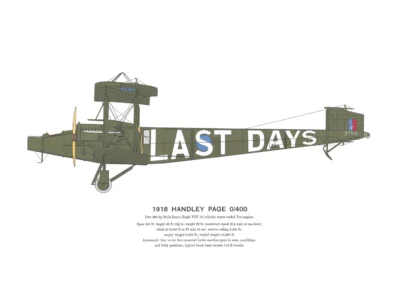Handley Page 0/400, 1918
£25.00
Handley Page 0/400: Large aircraft that introduced the concept of strategic bombing raids (scroll down for a more detailed Description)
Published 1962 by © Hugh Evelyn Limited; drawn by Roy Cross (1924-2008)
Print size: c. 48 x 35 cm (19″ x 14″) (may vary slightly from the printers’ cut 50 years ago)
Printed on medium white cardstock (137 g/sm²).
Print is LARGE size – shipping is the same for 1 to 10 prints (based on largest print size in your order) – see Shipping & Returns.
In stock
Description
Handley Page Limited was founded by Frederick Handley Page at Radlett airfield in 1909 north of London. Their WW I series of large night-bombers was a remarkable achievement. The O/400 was a refinement of the earlier 0/100, designed to an Admiralty specification for a dedicated bomber. In 1914 this was a revolutionary idea. 0/100s operated in France in 1916 and a revised design (increased fuel capacity and better engines) led to the O/400 bomber. 550 were built in Britain and 100 in the USA. The 0/400 was a very large aircraft, and in daylight would have been easy prey for capable German fighters. It was therefore used as a night-bomber and could carry ordnance up to the 749kg/1650lb bomb, the heaviest used by the British during WW I. Charged with attacking enemy industrial targets, the O/400s would fly in fleets of up to 40 a night. These raids were the first true strategic bombing raids in history, and the large Handley Page bombers were seen by some military leaders as the future of waging war. More than 400 O/400s operated with the Royal Air Force (formed in April) before the Armistice of November 1918. In August 1918 an O/400 was attached to No.1 Squadron of the Australian Flying Corps serving in the Middle East. No.1 worked with T.E. Lawrence, whose Arab associates, impressed by the sheer size of the aircraft, reportedly called it ‘The Father of all aeroplanes”.
Additional information
| Weight | 0.0226 kg |
|---|---|
| Dimensions | 48 × 35 cm |





